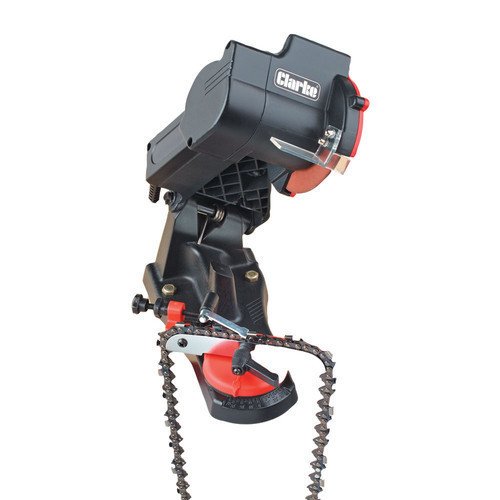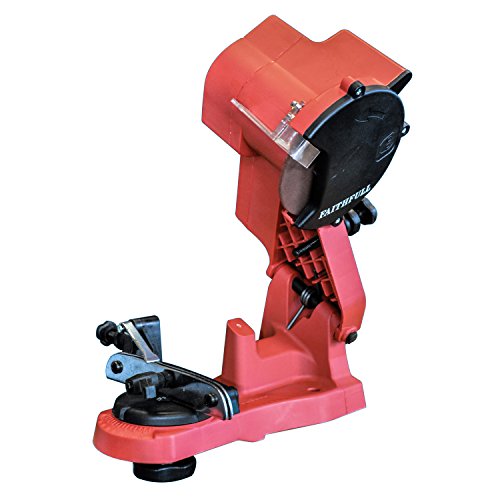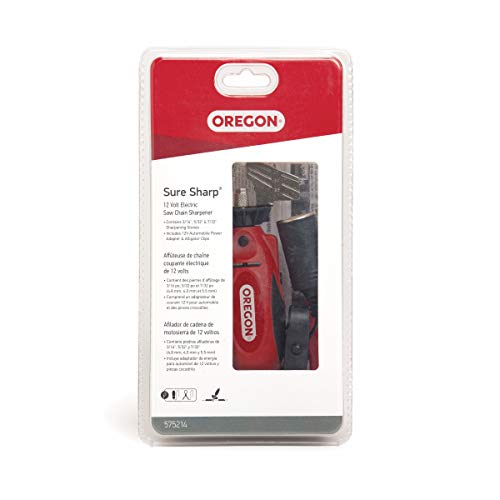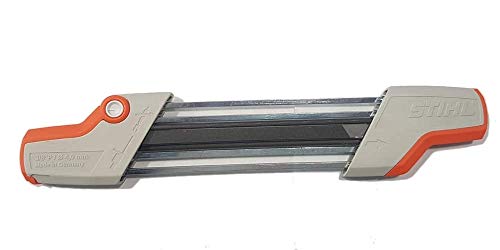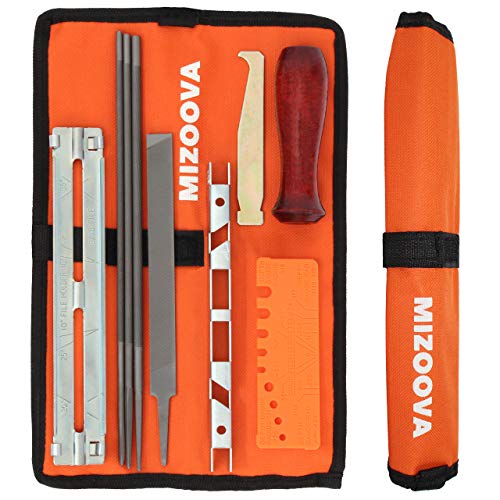A sure-fire way to tell that your chainsaw blades are getting dull is if you take longer to cut through wood and you feel tired quicker. You may also notice that the chainsaw is throwing up fine dust rather than the usual coarse chips when you are cutting.
Sharp blades are, however, not just important for cutting performance and ease of use. They also reduce the risk of injury from a chainsaw kickback.
A dull chainsaw can also result in bad cuts, and even your brand new safety helmet may not help you! 🙂
You can take your chainsaw for professional sharpening when the blades get dull. This keeps your chain in good working order but the costs add up quickly especially if you use it often.
Some people replace the chain altogether, an even more expensive solution.
A better and cheaper idea is to sharpen the chainsaw yourself. A good quality chainsaw sharpener won’t cost you much and with a little practice, you’ll find it easy to keep your chainsaw razor sharp.
In this buying guide, I review and compare the best chainsaw sharpeners, both electric and manual.
But first, here’s how to make sure you choose the right chainsaw sharpener for your needs.
What to Consider When Choosing a Chainsaw Sharpener
a) Manual vs. Electric
The first thing to decide is whether you want a manual or electric chainsaw sharpener.
A manual sharpening kit, which typically consists of 2-3 types of files, is cheaper and can be used in any environment since it doesn’t need a power connection. This makes a manual sharpener ideal for use when you are outdoors.
An electric sharpener is more suited to your workshop. Most electric chainsaw sharpeners are designed to be clamped onto a workbench, though there are smaller portable ones as well.
It takes less time and effort to sharpen with an electric sharpener. But it costs more compared to a simple manual file.
b) Type of File
The two main types of files are round and flat.
A round file is used to sharpen the side plate and top plate of the cutter while a flat file is used, along with a gauge, to shorten the rakers.
c) Size and Pitch
When you are sharpening the cutting edge of the cutter, it is essential that you use the right file size. Two types of sizes need to match between the chainsaw and file: pitch and tooth diameter.
Pitch is the distance between any three rivets divided by two. Most chainsaws have the pitch indicated on the side of the cutter or in the manual.
Make sure you pick a chainsaw sharpener that’s designed your cutters’ pitch. Most manufacturers will indicate which pitches the file is compatible with.
The other size to check is diameter. The diameter of the cutter should match that of the round file.
Note: One advantage of going with an electric chainsaw sharpener is that you don’t need to concern yourself with buying the right size. Electric sharpeners can be adjusted to fit any chain size.
d) Portability
If you do most of your cutting at home or a wood yard, portability is not that important. You can get a heavy electric chainsaw sharpener and bolt it to your workshop bench.
But if you travel a lot with your chainsaw, you’ll need something more portable.
A manual file kit is the most portable option. It’s light, compact and doesn’t need any power or batteries.
We recommend buying a chainsaw filing vice to make it easier to sharpen your chainsaw wherever you are.
There are also some smaller electric sharpeners designed for portability. You can usually connect it to a battery or a car cigarette lighter.
How to Use a Chainsaw Sharpener
Whether you are using a manual or electric sharpener, you have to sharpen the cutters one by one.
Because left and right cutters are angled differently, you’ll only sharpen every other cutter until you loop around the entire chain. Then angle the chainsaw the other way and sharpening the remaining cutters.
With an electric chainsaw sharpener, you’ll need to adjust various components to make sure the grinding plate sharpens at the right angle and depth. The sharpening angle for most files is 30 degrees.
With a manual file, you’ll need to use a file guide – usually included in the kit – to make sure you cut at the right angle.
Here are some additional tips for using a chainsaw sharpener.
- Mark the starting point to make sure you don’t sharpen any cutter more than once.
- Count the number of times you run the file across the first cutter and sharpen the other cutters the exact number of times. This ensures all teeth are sharpened evenly.
- When using a manual file, only run the file forwards. Never drag it backwards across the cutting edge.
- After sharpening the cutters 3-4 times, you’ll probably need to file down the depth gauges, also rakers. If the raker is higher than the cutter, your chainsaw won’t work properly. Use a depth gauge tool and flat file to reduce the height of the raker.
While you can sharpen your chainsaw several times over, it is important to know when it’s time to get a new chain.
If the teeth are chipped or badly damaged, get a new chain instead of trying to restore the cutters.
Some chainsaws also have a line on the cutters indicating when you should get a new chain.
The Best Chainsaw Sharpener Reviews
1. Clarke ECSS2 Electric Chainsaw Sharpener
If you are looking for an electric chainsaw sharpener for your workshop, we recommend the Clarke ECSS2.
It’s designed to work with all sizes and types of electric and petrol chainsaws. It’s easy to adjust the 108mm grinding plate to the angle and pitch of your chainsaw.
Using the rear fixing holes, it’s easy to mount the sharpener securely on a workbench. The chassis of the sharpener is metal, so it stays stable when you are using it.
As long as you’ve mounted it properly, it shouldn’t move around when you are sharpening your chainsaw.
Once you’ve set it up, using it is the easy part. Just set the chain on the holder and make all the necessary adjustments. Remember to make your starting position with a marker or piece of tape.
Once you get into the rhythm, you’ll find that it takes about five minutes to sharpen a chainsaw.
The grinding disc spins at 4800rpm, so you don’t need to apply any force when sharpening. Just let the disk barely touch the cutters.
The grinding disk takes some time before it wears out. You can sharpen your chainsaw several dozen times before you need a replacement disk, which costs less than £5.
The Clarke ECSS2 sharpener is powered by an 85W, 230V motor.
What I like about it:
- Easy to set up and use.
- Sharpens quickly and efficiently.
- Solid build quality.
- Versatile – works with all types and sizes of chainsaw chains.
2. Faithfull Power Plus CHAINSS 240V Electric Chainsaw Sharpener
The Faithfull Power Plus is a slight cheaper alternative to the Clarke ECSS2 electric chainsaw sharpener.
The main difference between them is build quality. While the ECSS2 feels solid and is mostly metal, the chassis of the Faithfull Power Plus sharpener is plastic.
It is good quality plastic. It doesn’t crack or wobble and users say it lasts a long time (it also comes with a 5-year guarantee).
Because of its construction, the Faithfull sharpener is more suited to hobbyists that use a chainsaw occasionally rather than pros who need to sharpen their chainsaw more frequently.
Mounting the Power Plus sharpener is easy. It comes ready with bolt holes but you’ll have to supply your own bolts.
Once you’ve mounted the sharpener, place your chain on the chain guide and adjust the grinder angle and depth.
Like the ECCS2 sharpener, Power Plus works with any pitch and diameter of chain. You just need to adjust the grinding plate to fit your chain profile.
The plate is high quality and lasts a long time. The replacement wheel is a bit more expensive than the ECSS2’s wheel but still costs less than £10.
The Faithfull Power Plus electric sharpener is powered by an 85W, 230V motor.
What I like about it:
- Easy to mount.
- Easy to use – takes about 5 minutes to adjust angles and depth and about the same time to sharpen an entire chain.
- Designed to last – it comes with a 5-year guarantee.
- Affordable.
3. Oregon 585015 12V Sure Sharp Electric Chainsaw Chain Grinder
If you prefer a portable electric chainsaw sharpener, the Oregon Sure Sharp 12V sharpener is the best one in the market.
It’s a lightweight and compact electric sharpener that you can connect directly to your car battery (battery clips are included) or plug into your car’s cigarette lighter socket.
The power cord is 5m long so you have plenty of length to work with.
The sharpener comes with four grinding stones for different chain sizes. All you need to do is pick the right stone for your chain and insert it into the sharpener.
Use the included wrench to tighten the stone onto the main unit.
You’ll need to do some adjustments to achieve the right cutting angle. Once you’ve aligned the grinder with the chain cutters, the rest is easy.
It takes about 5 minutes to sharpen a chain. The best part is that, unlike with mountable chainsaw sharpeners, you don’t need to take the chain off the chainsaw.
But you might need to buy a chainsaw vice to hold the chainsaw straight on a log or on the ground for easy sharpening.
What I like about it:
- Highly portable – perfect for arborists and tree cutters.
- Easy to use.
- Versatile – comes with grinders for use on different chain pitches.
4. Stihl 2-in-1 EasyFile
With a conventional chainsaw file, you have to file the cutters and depth gauges (rakers) separately. The Stihl 2-in-1 EasyFile cuts down on the amount of time you spend maintaining your chainsaw.
Instead of filing the two parts of the chain separately, it lets you sharpen them simultaneously. To do this, the EasyFile comes with two round files (one for the left cutters and another for the right cutters) and one flat file.
Stihl sells EastFiles for different chain sizes. This particular one is for chains with a cutter diameter of 4mm and a 3/8” pitch.
All you need to do is align the file at the right angle and start sharpening. Remember to use only a forward motion and mark where you start.
You’ll also need to buy a chainsaw vice that allows you to secure the chainsaw on a log or on the ground.
The individual files will wear away after some time. But Stihl sells replacements at an affordable price.
Note that the files are exclusive to EasyFile. You cannot replace them with any other round or flat files.
What I like about it:
- Saves time and effort – no need to file the rakers and cutters separately.
- Super easy to use.
- Highly portable.
5. MIZOOVA 10 Piece Chainsaw Sharpener File Kit
If you prefer a traditional chainsaw file, we recommend this 10-piece kit from MIZOOVA. It’s also a good choice if you are on a budget. It’s cheaper than all the other sharpeners we’ve reviewed.
Here’s what you get in the kit.
- Three round files for use on different chain sizes: 4mm, 4.8mm and 5.5mm
- One 6” flat file
- A filing guide holder with engraved angle guides
- A depth gauge to check the height of the rakers
- A quick check gauge
- A bar groove cleaner
- A wooden handle
- An orange storage pouch
The file guide easily fits the three round files. A quick lock mechanism allows you to switch between different file sizes in just a couple of seconds.
You can easily set the right filing angle using the engraved angle guides on the holder.
The pouch is handy for storing the files safely when not in use. It’s also useful if you travel a lot. It allows you to bring your sharpening tools wherever you go.
What I like about it:
- Kit contains everything you need to keep your chainsaw sharp.
- Versatile – works with different types and sizes of chainsaws.
- Good quality components.
- Highly portable.

